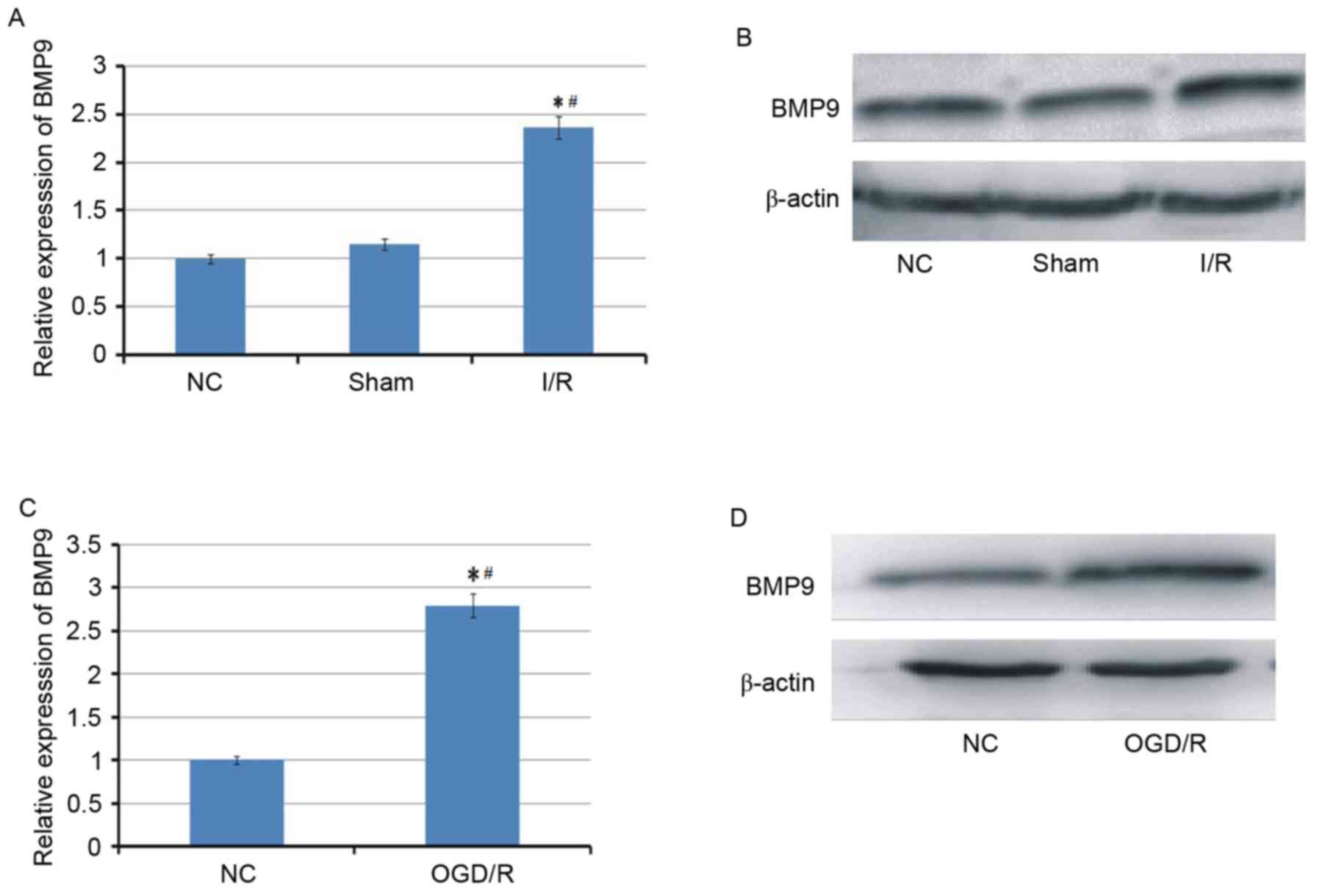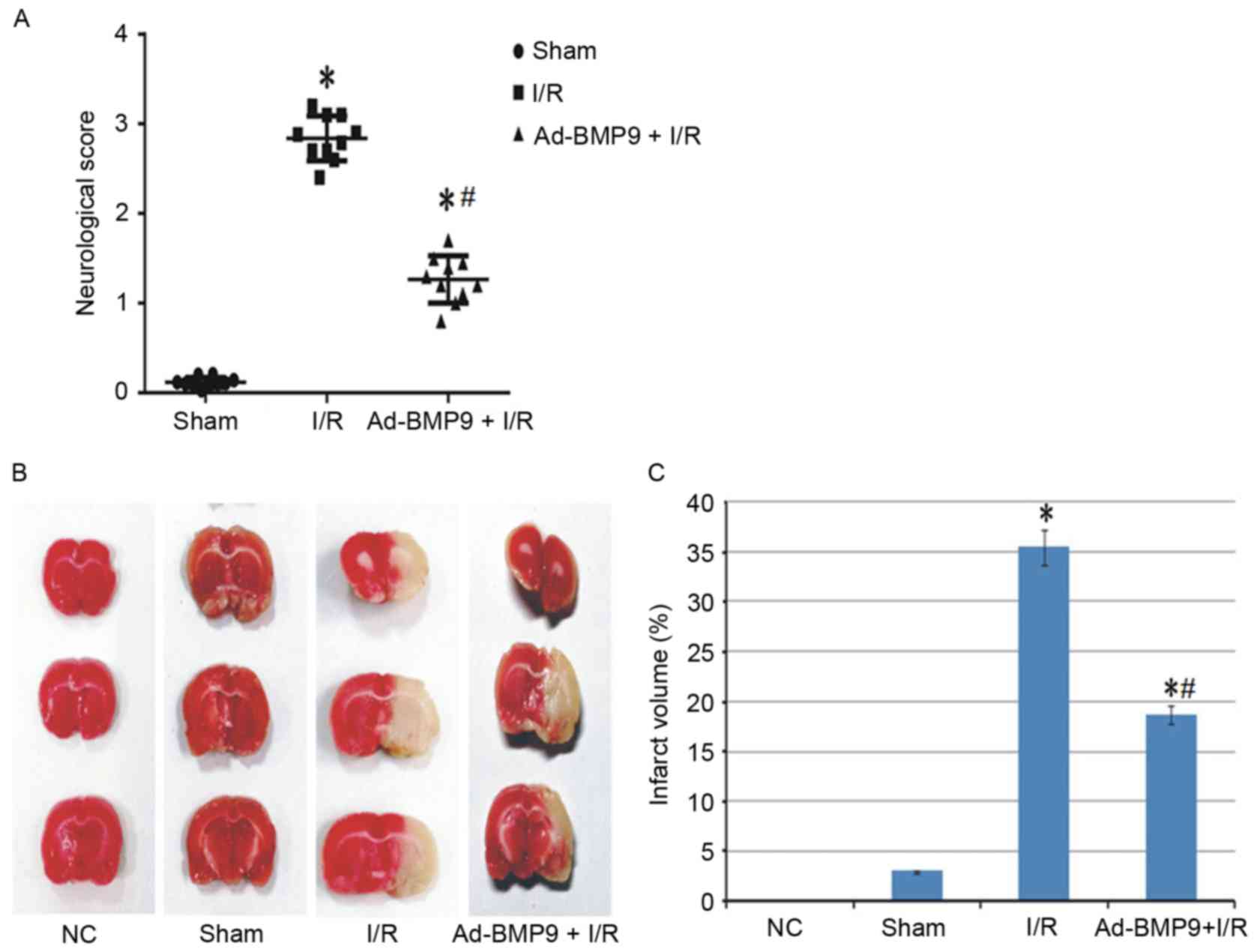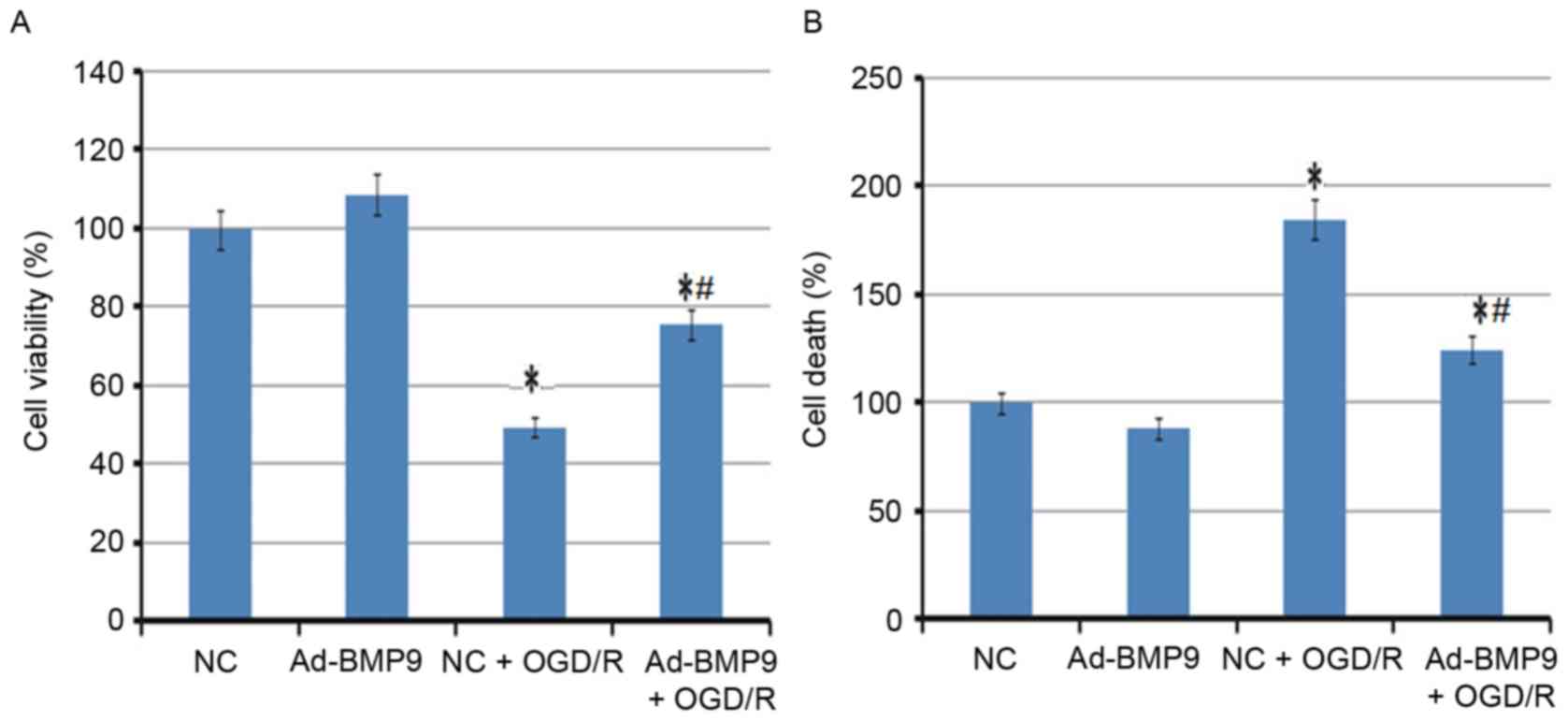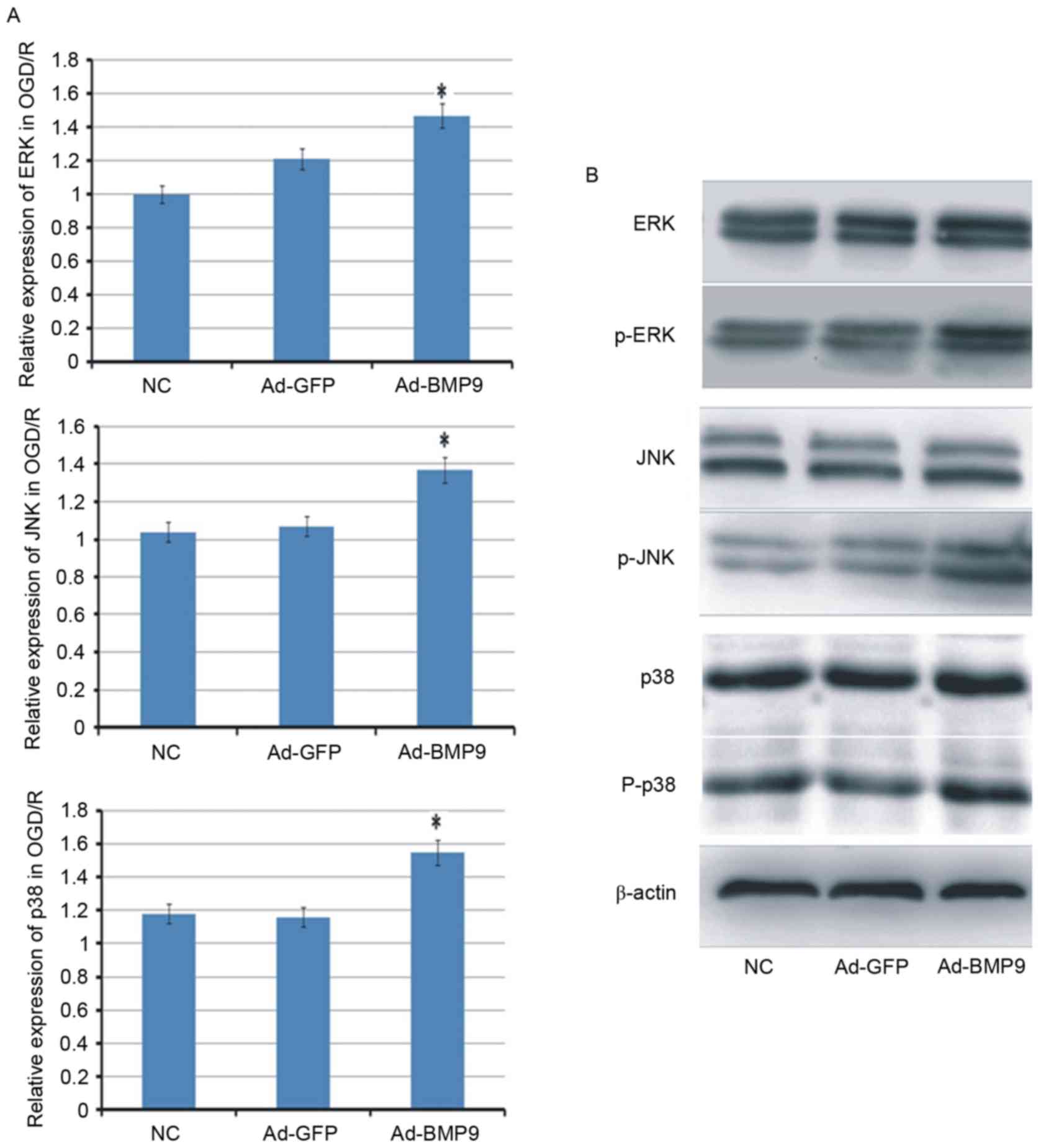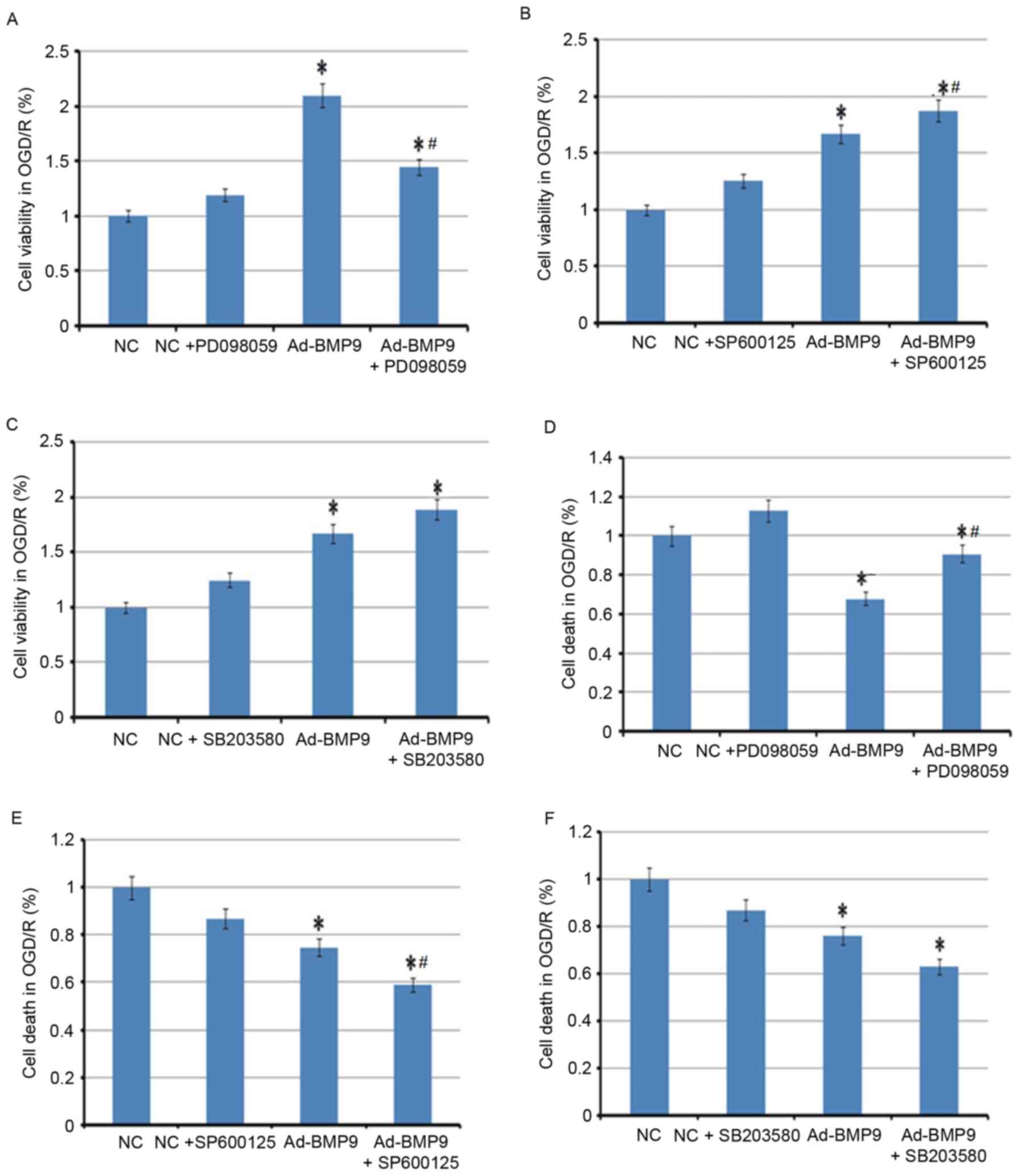Bone morphogenetic protein 9 serves a protective role in response to ischemic‑reperfusion in the brain by promoting ERK activation
- Authors:
- Published online on: December 11, 2017 https://doi.org/10.3892/mmr.2017.8253
- Pages: 2845-2852
-
Copyright: © Feng et al. This is an open access article distributed under the terms of Creative Commons Attribution License.
Abstract
Introduction
Stroke is the second most prevalent cause of mortality worldwide and ~8 million succumb to it annually (1). Ischemic stroke accounts for ~80% of strokes, and results from the occlusion of a major intracerebral artery by a thrombus or embolism (2). Re-canalization of occluded cerebral blood vessels is the effective approach to restore the cerebral flow and minimize deleterious effects of ischemia on neurons (3). However, several studies have indicated that ischemic-reperfusion (I/R) usually induces reactive oxygen species overproduction, which are highly deleterious and result in neuronal cell injury or death (4,5). Therefore, it has become important to explore ways to prevent cerebral I/R injuries.
Bone morphogenetic proteins (BMPs) are members of the transforming growth factor-β (TGF-β) superfamily that were originally identified as factors that induce the formation of bone and cartilage (6). However, recent studies indicate BMPs are also expressed in the central nervous system and involved in the growth, differentiation and apoptosis of neuronal cells under normal and pathological conditions, including cerebral I/R (7–9). BMP family members include the BMP-2/4 group (BMP2 and BMP4), osteogenic protein-1 group (BMP5, BMP6, BMP7 and BMP8) and BMP-9/10 group (BMP9 and BMP10) (10). Of these, certain members have been demonstrated to exert protective roles for cerebral I/R injuries. For example, Xu et al (11) demonstrated that the administration of rhBMP7 via a femoral vein injection 30 min prior to reperfusion significantly increases neurological function, decreases brain water content and pathological and morphological damage, and may be associated with reduced nuclear factor-κB activity. Using the same procedure, Pei et al (12) also demonstrated that BMP-7 significantly improves neurological deficiency and reduces the infarct volume via attenuating oxidative stress and inhibiting neuronal apoptosis following cerebral ischemia. By in vitro and vivo experimentation, Wang et al (13) demonstrated that BMP6 treatment may reduce cerebral ischemia/reperfusion injury by alleviating neuronal apoptosis, with decreased immunoreactivity, enzymatic activity of caspase-3, and density of terminal deoxynucleotidyl transferase dUTP nick end labeling-positive cells in the ischemic cortex. However, there have been no studies, to the best of the authors' knowledge, investigating the role of BMP9, a newly identified factor for developing basal forebrain cholinergic neurons (14), in cerebral I/R injuries.
The aim of the present study was to investigate whether BMP9 has a protective role in preventing focal cerebral (IR) injuries and their underlying mechanisms. The results may provide insight into the underlying functional role of BMP9 in the nervous system lesion and repair.
Materials and methods
Animals and experimental groups
Adult male Sprague-Dawley rats (n=40; 280–330 g; aged between 16 and 17 weeks) were obtained from the Experiment Animal Center of Chongqing Medical University. They were housed in rooms with controlled temperature (22–25°C), humidity (50–60%) and a 12-h light/dark cycle, with free access to food and water. All rats were randomly divided into four groups (n=10): i) Normal control; ii) sham surgery group; iii) I/R group; and iv) Ad-BMP9 + I/R group. All animal experiments were approved by the Institutional Animal Care and Use Committee of Chongqing Medical University and conducted in accordance with the principles and procedures outlined in the National Institutes of Health Guide for the Care and Use of Laboratory Animals (https://grants.nih.gov/grants/olaw/Guide-for-the-Care-and-use-of-laboratory-animals.pdf).
Construction of focal cerebral I/R model
The transient focal cerebral I/R injury model was induced via the right middle cerebral artery occlusion (MCAO) as described by Longa et al (15). Briefly, rats were anesthetized by intraperitoneal injection of 350 mg/kg chloral hydrate (Sigma-Aldrich; Merck KGaA, Darmstadt, Germany) following an overnight fast and placed in a supine position. A midline neck incision was made to expose the right common carotid artery, internal carotid artery (ICA) and external carotid artery (ECA). A 4-0 monofilament nylon suture (Ethicon, Inc., Osaka, Japan) with a rounded tip was inserted from the lumen of the ECA to that of the right ICA until a resistance was felt to occlude the origin of the right middle cerebral artery. Throughout the procedure, body temperature was maintained within the physiological range by a thermostatically controlled infrared lamp. Reperfusion was performed 2 h following MCAO via thread withdrawal. Sham-surgery rats underwent the same vessel exposure, however without MCAO.
Adenoviral vector (Ad)-BMP9 expression vector construction
The adenoviral vectors carrying BMP9 and/or GFP were obtained as a gift from Molecular Oncology Laboratory, the University of Chicago Medical Center (Chicago, IL, USA). They were constructed using the AdEasy System (Invitrogen; Thermo Fisher Scientific, Inc., Waltham, MA, USA) according to the manufacturer's protocol. The recombinant adenoviruses were further packaged and amplified in 293 cells (ATCC, Manassas, VA, USA) followed by storage at −80°C (16).
Intracerebroventricular infusion of Ad-BMP9
Ad-BMP9 was intracerebroventricularly injected into the rat brain 2 days prior to MCAO. In brief, rats were anesthetized with 10% chloral hydrate (3 ml/kg) and placed in a stereotaxic frame. Ad-BMP9 (0.1 ml) was injected into the right lateral ventricle via a 1 mm burr hole drilled 1.5 mm caudal to the bregma and 2 mm lateral to the midline. The needle was kept in the ventricle for 10 min, and then withdrawn. Following the closure of the wound, the rats were returned to their cages and fed as normal.
Evaluation of neurological deficits
Neurological deficits were evaluated 24 h following reperfusion according to the method of Longa et al (15). Neurological findings were scored on a 5-point scale: 0 points, no deficit; 1 point, failure to extend left forepaw; 2 points, circling to the left; 3 points, paresis to the left; 4 points, no walking spontaneously with depressed level of consciousness. The cerebral I/R model was considered to be successfully constructed with a neurological deficits score >3.
Estimation of cerebral infarct volume
The cerebral infarct volume was determined by 2,3,5-triphenyltetrazolium chloride (TTC) staining (17). Briefly, the rats were deeply anesthetized with chloral hydrate (10% chloral hydrate; 3 ml/kg) 24 h following reperfusion and then decapitated, following which the brains were rapidly removed and frozen at −20°C for 20 min. Brain tissue was sliced into five 2 mm sections and stained with 2% TTC solution for 30 min at 37°C in the dark followed by overnight immersion in 4% paraformaldehyde. The tissue slices were digitally photographed and the volume of the infarction (indicated as a white color) was analyzed and expressed as percentage relative to the total brain volume using the ImageJ software (version 1.37; National Institutes of Health, Bethesda, MD, USA).
Isolation and culture of astrocytes
Astrocytes were dissociated from eight neonatal Sprague-Dawley rats (Experiment Animal Center of Chongqing Medical University) (18). Briefly, the head of neonatal rats was cut off following anesthesia (10% chloral hydrate; 3 ml/kg) and the brains were removed from the skulls. Following careful removal of the meninges and pia mater, the brain tissues were cut into pieces by scissors and digested with trypsin for 10 min at 37°C, then plated on poly-L-lysine-coated culture dishes with Dulbecco's modified Eagle's medium (DMEM) (Gibco; Thermo Fisher Scientific, Inc.) supplemented with 10% fetal bovine serum (Gibco; Thermo Fisher Scientific, Inc.) in a humidified atmosphere of 5% CO2 at 37°C. The culture medium was changed every 2 days. When the primary cells reached 80–95% confluence, the cells were detached by trypsinization, centrifuged at 300 × g for 5 min at room temperature, and replaced. The subsequent passage cells were used for the following experiment when 85–100% confluence was achieved.
Simulation of oxygen-glucose deprivation and reoxygenation model
An oxygen-glucose deprivation and reoxygenation (OGD/R) model was constructed as previously described (19). Having being washed twice, astrocytes were immersed in glucose-free DMEM and placed in an incubator with a premixed gas (1% O2, 95% N2 and 5% CO2) for 4 h. Then, cells were maintained in normal DMEM (including 5.6 mmol/l glucose) and transferred to a 5% CO2 incubator at 37 °C for 24 h. For the non-OGD/R group, cultures were incubated in normal DMEM and placed in 5% CO2 in air at 37°C for 28 h. Astrocytes were also treated with Ad-GFP, Ad-BMP9, Ad-BMP9 + extracellular signal-regulated kinases (ERK) inhibitor PD098059 (20 µM; Sigma-Aldrich; Merck KGaA), Ad-BMP9 + c-Jun N-terminal kinase (JNK) inhibitor SP600125 (20 µm; Cell Signaling Technology, Inc., Danvers, MA, USA), Ad-BMP9 + p38 inhibitor SB203580 (20 µm; Cell Signaling Technology, Inc.), PD098059 (20 µm), SP600125 (20 µm), and SB203580 (20 µm) for 24 h and then subjected to OGD/R treatment.
Cell viability analysis
Cell viability was assessed by 3-(4,5-dimethylthiazol-2yl)-5-(3-carboxymethoxyphenyl)-(4-sulfophenyl)-2H-tetrazolium (MTS) method. Astrocytes were cultured in 96-well plates and MTS solution added. Following 3 h in the dark, cells were measured on a microplate reader at a wavelength of 490 nm (Bio-Rad Laboratories, Inc., Hercules, CA, USA).
Cell death analysis
A lactate dehydrogenase release assay was used to indirectly evaluate cytotoxicity (cell death) of astrocytes following OGD/R, which was performed using a commercially available kit (Nanjing Jiancheng Bioengineering Institute, Nanjing, China). Absorbance was detected at a wavelength of 450 nm on microplate reader (Bio-Rad Laboratories, Inc.).
Reverse transcription-quantitative polymerase chain reaction (RT-qPCR)
RT-qPCR was used to investigate the mRNA expression of BMP9, ERK, P38 and JNK. Total RNA was isolated from the brain tissues or astrocytes using RNAiso Plus (Takara Biotechnology Co., Ltd., Dalian, China) according to the manufacturer's protocol. cDNA was synthesized with PrimeScript RT reagent kit (Takara Biotechnology Co., Ltd.). The PCR primers used were: BMP9 forward, 5′-CCTTCTTTCATTCCCTCTGTGA-3′ and reverse, 5′-CCCAACCTTTTGACCCTTTTTA-3′, 143 bp; ERK forward, 5′-TGAAGGATGACGACTTTGAGAA-3′ and reverse, 5′-CTGTAGAACGCACCATAGAAGC-3′, 217 bp; P38 forward, 5′-GAGCGTTACCAGAACCTGTCTC-3′ and reverse, 5′-TGAATGATGGACTGAAATGGTC-3′, 128 bp; JNK forward, 5′-GACACGAAGACGAACTTGAGC-3′ and reverse, 5′-CGTAATAGGCAGGAAAGACACC-3′ 126 bp; and β-actin forward, 5′-CACCCGCGAGTACAACCTTC-3′ and reverse, 5′-CCCATACCCACCATCACACC-3′, 207 bp). Real-time qPCR was run on a Bio-Rad CFX-96 real-time PCR system (Bio-Rad Laboratories, Inc.) using SYBR Premix Ex Taq kit (Takara Biotechnology Co., Ltd.) at 95°C for 30 sec, followed by 39 cycles of 95°C for 5 sec, and 60°C for 30 sec. The gene expression levels relative to internal standard β-actin were calculated by the 2−ΔΔCq method (20).
Western blotting
Western blotting was used to investigate the protein expression of BMP9, ERK, P38 and JNK. The protein samples were extracted from brain tissues or astrocytes using RIPA lysis buffer (BioTeke Corporation, Beijing, China) and then protein levels were determined using the bichioninic acid method. A 20 µg protein sample was subjected to 12% SDS-PAGE gel and transferred onto polyvinylidene fluoride membranes. Blots were blocked with 5% non-fat milk solution for 1 h at room temperature and then incubated overnight with anti-BMP9 (cat. no. sc514211; 1:2,000; Santa Cruz Biotechnology, Inc., Dallas, TX, USA), anti-p-ERK (cat. no. BS74621; 1:2,000; Bioworld Technology, Inc., St. Louis Park, MN, USA), anti-p-P38 (cat. no. BS6381; 1:2,000; Bioworld Technology, Inc.), or anti-p-JNK (cat. no. Bs4763; 1:2,000; Bioworld Technology, Inc.) at 4°C followed by incubation with horseradish peroxidase-conjugated goat anti-rabbit IgG secondary antibodies (cat. no. ZB2301; 1:3,000; Beijing Zhongshan Jinqiao Biotechnology Co., Ltd., Beijing, China) for 1 h. The blots were visualized with the ECL system (GE Healthcare Life Sciences, Little Chalfont, UK) and the intensity of each band quantified by using the Chemi Doc XRS system.
Statistical analysis
RNA and protein assay data are presented as the mean ± standard error of the mean, which were repeated three times. Differences between groups were analyzed using Tukey's post hoc test following one-way analysis of variance through SPSS software, version 18.0 (SPSS, Inc., Chicago, IL, USA). A t-test was used to compare the differences between two groups. P<0.05 was considered to indicate a statistically significant difference. The area of TTC staining and cerebral infarction was photographed with a digital camera, and results analyzed using Image J software (version 1.37).
Results
Cerebral I/R induces the upregulated expression of BMP9
To investigate whether BMP9 is involved in cerebral I/R, the expression of BMP9 was first examined in cerebral I/R animal and cell models. As demonstrated in Fig. 1, BMP9 was identified to be upregulated at mRNA and protein levels in the cerebral I/R animal model triggered by MACO and the cell model following OGD/R treatment.
Effect of BMP9 overexpression on neurological function and infarction
To confirm whether the role of upregulated BMP9 is protective or deteriorative, BMP9 was overexpressed via adenovirus vector mediation followed by cerebral I/R treatment. Previous studies have suggested that cerebral I/R leads to neurological deficit and cerebral infarction (21,22). Thus, the role of BMP9 overexpression on neurological function was assessed according to the score defined by Longa et al (15) and infarct volume stained by TTC. As a result, normal and sham surgery rats presented almost no neurological deficit and infarct volume, however this significantly increased in the I/R group. Furthermore, BMP9 pretreatment significantly reduced the neurological score and infarct volume compared with I/R rats (Fig. 2).
Effect of BMP9 overexpression on cell viability and death of astrocytes
In addition to the animal model, the overexpression of BMP9 on astrocytes was also analyzed. In agreement with the animal experiment, cell viability of astrocytes was significantly reduced, however the death of astrocytes was enhanced following OGD/R treatment. However, the BMP9 pretreatment significantly alleviated this condition, with the increased cell viability and lower cell death rate (Fig. 3).
Underlying alleviation mechanism of BMP9 for cerebral I/R
To further explore the mechanism of BMP9 on cerebral I/R, three signaling pathways (p38, ERK and JNK) that usually serve important roles in cell survival, were determined. The results indicated that the mRNA expression levels of p38, ERK and JNK were all increased in OGD/R-treated astrocytes. At the protein levels, the expression of p38, ERK and JNK appeared to be similar in different groups, however, their phosphorylation levels were improved by BMP9 with different degrees (Fig. 4).
In addition, inhibitors of p38, ERK and JNK were also used to further demonstrate that the protective role of BMP9 in cerebral I/R is p38-, ERK- and JNK-mediated. Notably, only ERK inhibitor PD098059 was identified as reversing the protective role of BMP9, with the reduced cell viability and increased death of astrocytes compared with BMP9 alone, whereas the JNK inhibitor SP600125 and p38 inhibitor SB203580 further improved the protective role of BMP9, indicating the parallel mechanism with BMP9 (Fig. 5).
Discussion
Although accumulating evidence has demonstrated that BMP9 is expressed in brain neurons (14,23,24), this is the first study, to the best of the authors' knowledge, to explore its functional mechanism in cerebral I/R injuries. The results demonstrated that BMP9 is a protective response molecule that is significantly upregulated in the cerebral I/R animal and cell models. Pretreatment with BMP9 effectively ameliorates neurological defect and brain infarct volume, which may be associated with its ability to reduce death and improve viability of astrocytes. The findings of the present study appeared to be in line with previous studies on the other members of the BMP family (9,13,25).
BMP9 has been reported to exert its function on osteogenesis and the maintenance of bone cell survival by activating the downstream mitogen-activated protein kinase (MAPK) signaling pathway (26,27). It is also clear that MAPK pathway members, including ERK, JNK and p38, serve important roles in neuronal cells as a response to the stress stimuli induced by I/R (28). Inhibition of ERK by U0126 or PD98059 significantly decreases the number of surviving cells in hippocampal CA1 subfield and cortex (29), whereas activation of ERK significantly ameliorates neurological deficit and histopathology alterations in rats exposed to 90 min MCAO-induced ischemia and 24 h reperfusion (30,31). The alterations in JNK and p38 appeared to be contrary to ERK, with the inhibition of JNK and p38 attenuating infarction volume in I/R brains in vivo (32,33).
To further confirm whether the protective role of BMP9 in cerebral I/R injuries is MAPK signaling pathway mediated, the expression levels of ERK, JNK and p38 were measured in addition to the use of ERK, JNK and p38 inhibitors in the OGD/R injured neurons. Although the expression of ERK, JNK and p38 appeared to be increased following BMP9 treatment, only the ERK inhibitor partially reversed the effect of BMP9 on the death and viability of astrocytes, indicating that activation of ERK may be a mechanism underlying the neuroprotective effects of BMP9.
The present study has certain limitations. First, the investigation of the neuroprotection effect of BMP9 in vivo was relatively simple. Apoptosis and proliferation of neurons and the effect of ERK inhibitor were not analyzed. Second, the neurological deficit score and infarct volume were evaluated only at 24 h of reperfusion and the long-term effect of BMP9 on neurological outcome remains unclear. Third, the downstream mediators of ERK were not assessed in vitro and in vivo.
In conclusion, the present study preliminarily demonstrated that pretreatment with BMP-9 may be a promising option for the prevention of cerebral I/R injuries, and may reduce death and maintain the growth of neurons by stimulating the ERK signaling pathway.
References
|
Roger VL, Go AS, Lloyd-Jones DM, Adams RJ, Berry JD, Brown TM, Carnethon MR, Dai S, de Simone G, Ford ES, et al: Heart disease and stroke statistics-2011 update: A report from the American Heart Association. Circulation. 123:e18–e209. 2011. View Article : Google Scholar : PubMed/NCBI | |
|
Stoll G, Kleinschnitz C and Nieswandt B: Molecular mechanisms of thrombus formation in ischemic stroke: Novel insights and targets for treatment. Blood. 112:3555–3562. 2008. View Article : Google Scholar : PubMed/NCBI | |
|
Deb P, Sharma S and Hassan KM: Pathophysiologic mechanisms of acute ischemic stroke: An overview with emphasis on therapeutic significance beyond thrombolysis. Pathophysiology. 17:197–218. 2010. View Article : Google Scholar : PubMed/NCBI | |
|
Sanderson TH, Reynolds CA, Kumar R, Przyklenk K and Hüttemann M: Molecular mechanisms of ischemia-reperfusion injury in brain: Pivotal role of the mitochondrial membrane potential in reactive oxygen species generation. Mol Neurobiol. 47:9–23. 2013. View Article : Google Scholar : PubMed/NCBI | |
|
Wang M, Li YJ, Ding Y, Zhang HN, Sun T, Zhang K, Yang L, Guo YY, Liu SB, Zhao MG and Wu YM: Silibinin prevents autophagic cell death upon oxidative stress in cortical neurons and cerebral ischemia-reperfusion Injury. Mol Neurobiol. 53:932–943. 2016. View Article : Google Scholar : PubMed/NCBI | |
|
Reddi AH: Regulation of cartilage and bone differentiation by bone morphogenetic proteins. Curr Opin Cell Biol. 4:850–855. 1992. View Article : Google Scholar : PubMed/NCBI | |
|
Liu A and Niswander LA: Bone morphogenetic protein signalling and vertebrate nervous system development. Nat Rev Neurosci. 6:945–954. 2005. View Article : Google Scholar : PubMed/NCBI | |
|
Chalazonitis A and Kessler JA: Pleiotropic effects of the bone morphogenetic proteins on development of the enteric nervous system. Dev Neurobiol. 72:843–856. 2012. View Article : Google Scholar : PubMed/NCBI | |
|
Zhang R, Pei H, Ru L, Li H and Liu G: Bone morphogenetic protein 7 upregulates the expression of nestin and glial fibrillary acidic protein in rats with cerebral ischemia-reperfusion injury. Biomed Rep. 1:895–900. 2013. View Article : Google Scholar : PubMed/NCBI | |
|
Miyazono K, Kamiya Y and Morikawa M: Bone morphogenetic protein receptors and signal transduction. J Biochem. 147:35–51. 2010. View Article : Google Scholar : PubMed/NCBI | |
|
Xu JH, Zhang TZ, Zhao YY, Wang JK and Yuan ZG: Protective effects of recombinant human bone morphogenetic protein-7 on focal cerebral ischemia-reperfusion injury. Int J Neurosci. 123:375–384. 2013. View Article : Google Scholar : PubMed/NCBI | |
|
Pei H, Cao D, Guo Z, Liu G, Guo Y and Lu C: Bone morphogenetic protein-7 ameliorates cerebral ischemia and reperfusion injury via inhibiting oxidative stress and neuronal apoptosis. Int J Mol Sci. 14:23441–23453. 2013. View Article : Google Scholar : PubMed/NCBI | |
|
Wang Y, Chang CF, Morales M, Chou J, Chen HL, Chiang YH, Lin SZ, Cadet JL, Deng X, Wang JY, et al: Bone morphogenetic protein-6 reduces ischemia-induced brain damage in rats. Stroke. 32:2170–2178. 2001. View Article : Google Scholar : PubMed/NCBI | |
|
Schnitzler AC, Mellott TJ, Lopez-Coviella I, Tallini YN, Kotlikoff MI, Follettie MT and Blusztajn JK: BMP9 (bone morphogenetic protein 9) induces NGF as an autocrine/paracrine cholinergic trophic factor in developing basal forebrain neurons. J Neurosci. 30:8221–8228. 2010. View Article : Google Scholar : PubMed/NCBI | |
|
Longa EZ, Weinstein PR, Carlson S and Cummins R: Reversible middle cerebral artery occlusion without craniectomy in rats. Stroke. 20:84–91. 1989. View Article : Google Scholar : PubMed/NCBI | |
|
Zhao C, Wu N, Deng F, Zhang H, Wang N, Zhang W, Chen X, Wen S, Zhang J, Yin L, et al: Adenovirus-mediated gene transfer in mesenchymal stem cells can be significantly enhanced by the cationic polymer polybrene. PLoS One. 9:e929082014. View Article : Google Scholar : PubMed/NCBI | |
|
Bederson JB, Pitts LH, Germano SM, Nishimura MC, Davis RL and Bartkowski HM: Evaluation of 2,3,5-triphenyltetrazolium chloride as a stain for detection and quantification of experimental cerebral infarction in rats. Stroke. 17:1304–1308. 1986. View Article : Google Scholar : PubMed/NCBI | |
|
Chen H, Tian M, Jin L, Jia H and Jin Y: PUMA is invovled in ischemia/reperfusion-induced apoptosis of mouse cerebral astrocytes. Neuroscience. 284:824–832. 2015. View Article : Google Scholar : PubMed/NCBI | |
|
Dong YF, Chen ZZ, Zhao Z, Yang DD, Yan H, Ji J and Sun XL: Potential role of microRNA-7 in the anti-neuroinflammation effects of nicorandil in astrocytes induced by oxygen-glucose deprivation. J Neuroinflammation. 13:602016. View Article : Google Scholar : PubMed/NCBI | |
|
Livak KJ and Schmittgen TD: Analysis of relative gene expression data using real-time quantitative PCR and the 2(-Delta Delta C(T)) method. Methods. 25:402–408. 2001. View Article : Google Scholar : PubMed/NCBI | |
|
Moskowitz MA, Lo EH and Iadecola C: The science of stroke: Mechanisms in search of treatments. Neuron. 67:181–198. 2010. View Article : Google Scholar : PubMed/NCBI | |
|
Lo EH: Experimental models, neurovascular mechanisms and translational issues in stroke research. Br J Pharmacol. 153 Suppl 1:S396–S405. 2008. View Article : Google Scholar : PubMed/NCBI | |
|
López-Coviella I, Berse B, Krauss R, Thies RS and Blusztajn JK: Induction and maintenance of the neuronal cholinergic phenotype in the central nervous system by BMP-9. Science. 289:313–316. 2000. View Article : Google Scholar : PubMed/NCBI | |
|
Lopez-Coviella I, Follettie MT, Mellott TJ, Kovacheva VP, Slack BE, Diesl V, Berse B, Thies RS and Blusztajn JK: Bone morphogenetic protein 9 induces the transcriptome of basal forebrain cholinergic neurons. Proc Natl Acad Sci USA. 102:pp. 6984–6989. 2005; View Article : Google Scholar : PubMed/NCBI | |
|
Luan L, Yang X, Zhou C, Wang K and Qin L: Post-hypoxic and ischemic neuroprotection of BMP-7 in the cerebral cortex and caudate-putamen tissue of rat. Acta Histochem. 117:148–154. 2015. View Article : Google Scholar : PubMed/NCBI | |
|
Fong D, Bisson M, Laberge G, Mcmanus S, Grenier G, Faucheux N and Roux S: Bone morphogenetic protein-9 activates Smad and ERK pathways and supports human osteoclast function and survival in vitro. Cell Signal. 25:717–728. 2013. View Article : Google Scholar : PubMed/NCBI | |
|
Ye G, Li C, Xiang X, Chen C, Zhang R, Yang X, Yu X, Wang J, Wang L, Shi Q and Weng Y: Bone morphogenetic protein-9 induces PDLSCs osteogenic differentiation through the ERK and p38 signal pathways. Int J Med Sci. 11:1065–1072. 2014. View Article : Google Scholar : PubMed/NCBI | |
|
Kovalska M, Kovalska L, Pavlikova M, Janickova M, Mikuskova K, Adamkov M, Kaplan P, Tatarkova Z and Lehotsky J: Intracellular signaling MAPK pathway after cerebral ischemia-reperfusion injury. Neurochem Res. 37:1568–1577. 2012. View Article : Google Scholar : PubMed/NCBI | |
|
Zhu YM, Wang CC, Chen L, Qian LB, Ma LL, Yu J, Zhu MH, Wen CY, Yu LN and Yan M: Both PI3K/Akt and ERK1/2 pathways participate in the protection by dexmedetomidine against transient focal cerebral ischemia/reperfusion injury in rats. Brain Res. 1494:1–8. 2013. View Article : Google Scholar : PubMed/NCBI | |
|
Wang PR, Wang JS, Zhang C, Song XF, Tian N and Kong LY: Huang-Lian-Jie-Du-Decotion induced protective autophagy against the injury of cerebral ischemia/reperfusion via MAPK-mTOR signaling pathway. J Ethnopharmacol. 149:270–280. 2013. View Article : Google Scholar : PubMed/NCBI | |
|
Yang S, Yuan Y, Jiao S, Luo Q and Yu J: Calcitonin gene-related peptide protects rats from cerebral ischemia/reperfusion injury via a mechanism of action in the MAPK pathway. Biomed Rep. 4:699–703. 2016. View Article : Google Scholar : PubMed/NCBI | |
|
Gong J, Sun F, Li Y, Zhou X, Duan Z, Duan F, Lei Z, Chen H, Qi S and Shen J: Momordica charantia polysaccharides could protect against cerebral ischemia/reperfusion injury through inhibiting oxidative stress mediated c-Jun N-terminal kinase 3 signaling pathway. Neuropharmacology. 91:123–134. 2015. View Article : Google Scholar : PubMed/NCBI | |
|
Wang W, Tang L, Yong L and Yong W: Biochanin a protects against focal cerebral ischemia/reperfusion in rats via inhibition of p38-mediated inflammatory responses. J Neurol Sci. 348:121–125. 2015. View Article : Google Scholar : PubMed/NCBI |



